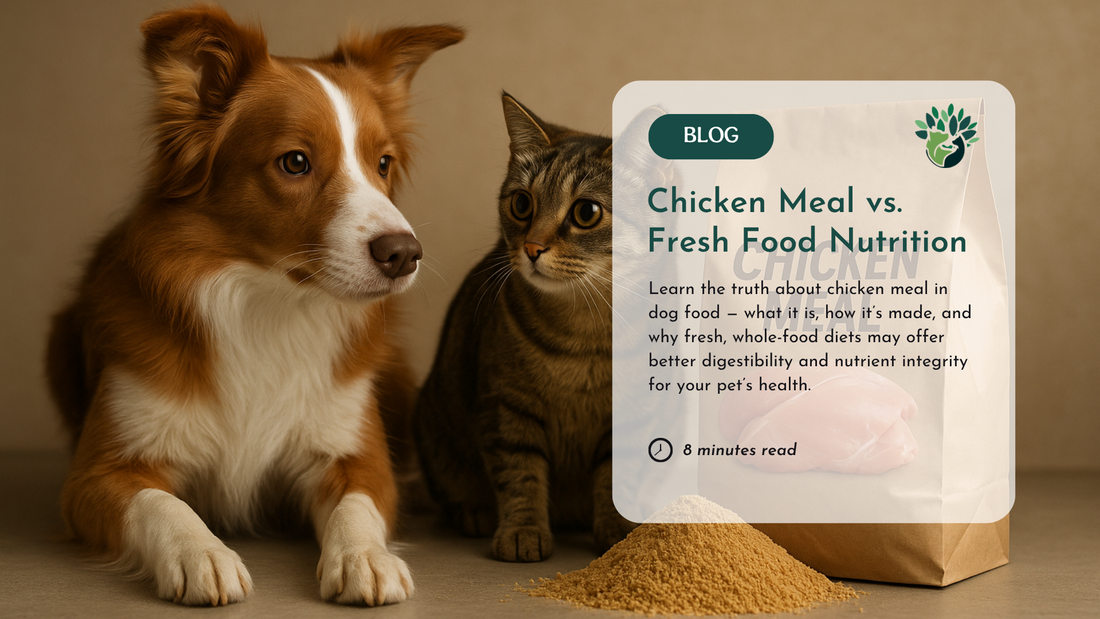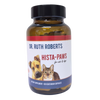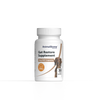As a caring pet parent, you’ve probably asked yourself, “What is chicken meal in dog food?” or “What is chicken by-product meal?” When scanning a pet food label, seeing “chicken meal” or “meat by-product meal” may sound reassuring. But from a nutritional science perspective, there’s a meaningful difference between those processed “meal” ingredients and fresh, whole-food ingredients. The key lies in how these ingredients are made, in particular the rendering process used in many pet foods. Understanding this process can help you choose a diet that supports your pet’s health rather than potentially adding hidden burdens.
What Is Rendering (and What It Means for Nutrition)
Rendering is an industrial process where animal tissues (often including off-cuts, bones, organs, etc.) are cooked, pressed, dried and ground into a “meal” form. The exact parameters vary by manufacturer and country.
Chicken meal is the dry, rendered product from clean chicken flesh and skin, with or without bone. Similarly, chicken by-product meal can include other animal tissues such as organs, bones, and off-cuts. These ingredients are cooked under high heat, pressed, and ground into powder form to concentrate protein. Some important nutritional concerns associated with rendering or heavy processing include:
1. Protein denaturation / reduced digestibility
Research comparing chicken meal vs less-processed chicken found that chicken meal had lower standardized digestibility of indispensable amino acids than steamed chicken in dogs. For example, lysine, valine, histidine and threonine digestibilities were under 80% in the chicken meal group.
Another study concluded that meat-meal (MM) ingredients had significantly lower soluble protein content and in vitro digestibility compared with fresh-meat (FM) formulations, confirming that protein quality and bioavailability are higher in diets made with fresh meat sources
2. Fat oxidation & nutrient loss
It is well-known that high temperatures used in rendering can reduce the digestibility of proteins in animal by-product meals (Chuppava et al., 2023). In one controlled study, researchers from Iowa State University simulated the rendering process by heating chicken by-product meal at 100 °C for 72 hours. The oxidized meal showed lower protein and energy digestibility and poorer feed efficiency compared with unheated meal (Frame et al., 2021). This occurs because oxidation damages amino acids and fatty acids, making them less available for digestion and use by the body, even though the crude protein percentage on the label may remain high.
3. Transparency of ingredient source
While not every “meal” ingredient is automatically bad, it’s important to remember that even the best-rendered meals are still highly processed. The rendering process—by its nature, involves high heat and pressure that inevitably reduce the biological value of the proteins and fats, no matter how clean the starting materials are.
Some manufacturers may use named meals like “chicken meal” or “turkey meal” from better raw ingredients, but these are still nutritionally inferior to fresh, whole-food sources in terms of digestibility, amino acid integrity, and natural enzyme content. They can meet minimum nutrient standards, but they don’t provide the same vitality or anti-inflammatory benefits that come from fresh, gently cooked foods.
That’s why true nutritional transparency matters. Brands that openly share ingredient sourcing and processing methods demonstrate accountability—but ultimately, your pet thrives best on food that’s closest to its natural, whole form, not one that’s been cooked, pressed, and dehydrated into powder.
Why Fresh / Whole Food Ingredients Can Be Advantageous
Rendered meals such as “chicken meal” or “meat meal” are produced through high-heat processing that removes moisture and concentrates protein but can also reduce some natural nutrients, enzymes, and amino acids. Fresh, whole food ingredients are vastly superior to rendered meal-based commercial pet foods for a multitude of reasons. Let’s break this down so you can see why fresh food is not just a trend but a transformative approach to your pet’s health.
1. Nutritional Integrity
Fresh, whole-food ingredients tend to retain more of their original nutrients because they’re minimally processed. Meats provide complete amino acids, while vegetables, fruits, and healthy fats supply naturally occurring vitamins, minerals, and essential fatty acids.
2. Digestibility and Bioavailability
Lightly cooked or fresh ingredients are generally easier for the body to digest because their nutrients remain closer to their natural state. Rendered meals may have lower amino acid availability due to heat exposure, though digestibility can vary depending on ingredient quality and processing.
3. Additives and Preservatives
Rendered meal–based diets often rely on preservatives and stabilizers to extend shelf life. Fresh or gently cooked foods typically need fewer additives, allowing you to have more control over what your pet eats.
4. Hydration
Dry foods made with rendered meals are naturally low in moisture, which means pets need to drink more water to stay hydrated. Fresh and gently cooked foods contain more natural moisture, which can help support adequate hydration.
5. Inflammation and Processing
High-heat cooking can lead to the formation of advanced glycation end products (AGEs), compounds linked to inflammation in general nutrition research. Minimally processed foods are less likely to contain these compounds and may preserve more of their natural antioxidants.
6. Transparency
Fresh foods make it easy to recognize the ingredients in your pet’s bowl. Rendered meal–based products often use broader terms like “meat meal” or “poultry by-product meal,” which can make it harder to know the exact source. Choosing brands that clearly state their ingredient sources supports informed decision-making.
7. Overall Well-Being
Many pet parents report positive differences when transitioning to diets made from fresh, whole ingredients. Responses vary between pets, but supporting nutrition with recognizable, minimally processed ingredients can contribute to balanced overall wellness.
8. Food as Care
Feeding is an opportunity to nourish your pet with thoughtful, balanced nutrition. Selecting whole, fresh, or gently processed foods allows you to align your pet’s diet more closely with natural nutrient sources, without unnecessary additives or excess processing.
|
Nutritional Metric |
Rendered "Meal" Ingredients |
Fresh, Whole Food Ingredients |
|
Protein Bioavailability |
Low (due to denaturation) |
High (protein structure intact) |
|
Fat Quality |
Oxidized; requires synthetic preservation |
Intact essential fatty acids (Omega-3s) |
|
Nutrient Loss |
High loss of heat-labile vitamins/enzymes |
Minimal loss |
|
Transparency |
Low (Source materials are varied) |
High (You know exactly what the food is) |
Recommendations for Pet Parents
-
Read labels — and beyond.
If you see terms like “chicken meal” or “poultry by-product meal,” take a moment to look deeper. Ask: What’s the overall recipe made of? How was it processed? Ingredients tell part of the story, but the method of preparation and sourcing quality matter just as much. -
Prioritize transparency.
Brands that openly share where their ingredients come from, how they’re processed (for example, lower-heat cooking, minimal oxidation), and how quality is tested tend to inspire more confidence. True transparency reflects integrity. -
Match food to your pet’s needs.
Pets with sensitivities, digestive issues, or inflammatory conditions often do better on diets made from gently cooked or fresh ingredients, where nutrients are easier to absorb and the ingredient list is simpler and cleaner. -
Look past the protein percentage.
A high crude protein number doesn’t always mean better nutrition. What matters is how digestible and bioavailable those proteins are — something that’s often higher in fresh or minimally processed foods compared to heavily rendered meals. -
Think about balance, not just labels.
Whatever food you choose, make sure it meets complete and balanced nutritional standards (such as AAFCO or FEDIAF). Fresh food diets can easily achieve this when properly formulated. -
Add variety and rotation.
Introducing different fresh proteins and whole-food ingredients can provide a broader nutrient spectrum and reduce dependence on any one processed formula. Rotation helps keep your pet’s gut adaptable and resilient. -
Watch your pet, not just the package.
Your pet’s coat, digestion, stool quality, and energy are the most honest indicators of whether their diet is working for them. A shiny coat and steady energy often speak louder than any marketing claim.
Conclusion: Choose Nutrient Integrity (With Nuance)
There’s strong evidence that minimally processed, fresh, whole-food ingredients offer better nutrient preservation and digestibility compared to many rendered “meal” ingredients. The rendering process can degrade delicate proteins and fats, leading to potential nutrient loss and oxidation.
But choosing better nutrition doesn’t have to feel overwhelming. If you’re ready to move your pet toward a fresher, more balanced way of eating, start with simple, real ingredients and build from there.
For pet parents who want guidance, The Crockpet Diet Recipe provides a flexible, veterinarian-formulated framework for preparing balanced, home-cooked meals using whole foods. Supportive supplements can help fill nutritional gaps, especially during transitions from commercial kibble to fresh feeding.
And if you’re not sure where to start — or live far from a trusted vet — consulting with a holistic pet health coach online can be an accessible way to tailor a balanced diet to your pet’s specific needs and lifestyle.
Ultimately, it’s about progress, not perfection. Each step toward fresher, more transparent nutrition helps support your pet’s long-term health and vitality.
















